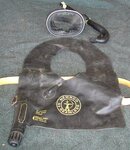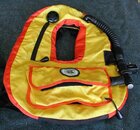Eric Sedletzky
Contributor
OK, so there's a lot of philosophies out there about what the size an air cell should be for different applications.
It is mentioned that a wing or air cell has to do two things, compensate for the added weight when a suit compresses at depth and it has to be able to float a rig on the surface.
My question is when did these rules come into play and who says?
I see the first thing as true, an air cell is designed to compensate for the added weight caused by suit compression at depth.
I do not agree however with the statement that a wing has to float a rig on the surface.
Years ago divers used no BC's so they didn't have any compensation at depth except for their lungs and they certainly didn't have any floatation to keep the rig on the surface and they dove just fine. Later the horse collar came along which in time allowed for depth compensation but still no floatation of the rig at surface.
Finally a jacket comes along that depth compensates but being an all in one unit now has the by product of being able to float on it's own on the surface via the inflated bladder.
Now days there are a multitude of different systems including old school stuff, plain jacket BC's, weight integrated jacket BC's, back inflate weight integrated BC's, BP/W BC's, and now user set up weight integrated BP/W BC's.
So somewhere in all this came the rationalle that the tank rig system had to be able to float on it's own. I even remember in PADI open water they had us do a BC remove and put back on on the surface with the rig floating around. I was using a rear inflate at the time and got so frustrated trying to put the thing on inflated that I finally let all the air out to be able to put it on.
I have used a 4 pound backplate with an HP steel tank wearing a thick 7mm suit, 20 pound weightbelt and an 18 pound wing and had plenty of depth compensation diving as deep as I need to go. The wing was responsible for covering the compression of my suit which was probably around 10 to 12 pounds of loss. An 18 Lb wing worked fine with room to spare. However the rig would not float well on the surface with a fully inflated wing and it would slowly make it's way down. Maybe those Oxycheq wings are not rated right because a steel 120 with a 4 pound plate should be less than 18 pounds in water but who knows .
.
Let's say I was using a 6 pound plate, same 120 tank, but I had extra weights on the plate lets say 4 pounds, and a two pound tank weight, and now a 12 pound weightbelt and the same 18 pound wing. Essentially nothing has changed underwater, I should still have enough depth compensation to do the dive. However now on the surface that rig will drop like a rock. So with the float the rig on the surface theory I should have to step up the wing to 30 or even 40 pound size because remember even with the first rig it was negative and made it's way down. So now stepping up the size of the wing just to see it float on the surface means I need a much bigger wing which also means more drag and more air sloshing around. I'm still only needing 10 to 12 pounds lift to cover crush but Now I have that small amount of air wandering from side to side in a big floppy wing, just so I can float it on the surface, Really???
There are times I dive with no BC at all. How do you suppose I am to float a steel tank and plate on the surface with NO wing, but I can dive just fine?
It is mentioned that a wing or air cell has to do two things, compensate for the added weight when a suit compresses at depth and it has to be able to float a rig on the surface.
My question is when did these rules come into play and who says?
I see the first thing as true, an air cell is designed to compensate for the added weight caused by suit compression at depth.
I do not agree however with the statement that a wing has to float a rig on the surface.
Years ago divers used no BC's so they didn't have any compensation at depth except for their lungs and they certainly didn't have any floatation to keep the rig on the surface and they dove just fine. Later the horse collar came along which in time allowed for depth compensation but still no floatation of the rig at surface.
Finally a jacket comes along that depth compensates but being an all in one unit now has the by product of being able to float on it's own on the surface via the inflated bladder.
Now days there are a multitude of different systems including old school stuff, plain jacket BC's, weight integrated jacket BC's, back inflate weight integrated BC's, BP/W BC's, and now user set up weight integrated BP/W BC's.
So somewhere in all this came the rationalle that the tank rig system had to be able to float on it's own. I even remember in PADI open water they had us do a BC remove and put back on on the surface with the rig floating around. I was using a rear inflate at the time and got so frustrated trying to put the thing on inflated that I finally let all the air out to be able to put it on.
I have used a 4 pound backplate with an HP steel tank wearing a thick 7mm suit, 20 pound weightbelt and an 18 pound wing and had plenty of depth compensation diving as deep as I need to go. The wing was responsible for covering the compression of my suit which was probably around 10 to 12 pounds of loss. An 18 Lb wing worked fine with room to spare. However the rig would not float well on the surface with a fully inflated wing and it would slowly make it's way down. Maybe those Oxycheq wings are not rated right because a steel 120 with a 4 pound plate should be less than 18 pounds in water but who knows
 .
.Let's say I was using a 6 pound plate, same 120 tank, but I had extra weights on the plate lets say 4 pounds, and a two pound tank weight, and now a 12 pound weightbelt and the same 18 pound wing. Essentially nothing has changed underwater, I should still have enough depth compensation to do the dive. However now on the surface that rig will drop like a rock. So with the float the rig on the surface theory I should have to step up the wing to 30 or even 40 pound size because remember even with the first rig it was negative and made it's way down. So now stepping up the size of the wing just to see it float on the surface means I need a much bigger wing which also means more drag and more air sloshing around. I'm still only needing 10 to 12 pounds lift to cover crush but Now I have that small amount of air wandering from side to side in a big floppy wing, just so I can float it on the surface, Really???
There are times I dive with no BC at all. How do you suppose I am to float a steel tank and plate on the surface with NO wing, but I can dive just fine?








